
Failing to diagnose and failing to act on the diagnosis of oligohydramnios can lead to severe and permanent damage to the baby.Įven if the mother is diagnosed with Oligohydramnios, major complications and risk can be avoided if the doctor acts quickly and efficiently. Oligohydramnios and Medical MalpracticeĪs mentioned above, it is crucial for the healthcare provider to watch over the fetus throughout the pregnancy. However, Oligohydramnios can only be detected and diagnosed by a doctor or healthcare provider so it is crucial that medical professionals maintain consistent and careful neonatal checkups with the expecting mother. The mother should let her healthcare provider know if she is leaking fluid from her vagina during pregnancy. In addition, the doctor may observe other factors that could indicate Oligohydramnios, such as the mother not gaining weight during her pregnancy or the baby growing too slowly.

If an AFI shows a fluid level of less than 5 centimeters, the absence of a fluid pocket 2-3 cm in depth, or a volume less than 500mL, then the doctor may suspect oligohydramnios. There are two ways to measure the level of the fluid: (1) amniotic fluid index (AFI) and (2) maximum vertical pocket (MPV). The healthcare provider will use an ultrasound to measure the amount of amniotic fluid. Oligohydramnios are diagnosed by the doctor during prenatal checkups. Some risks include, the baby growing too slowly, problems during labor and birth, oxygen being caught off to the baby, and a need for emergency cesarean surgery. Although, the risks are not as severe if oligohydramnios develops in the third trimester, the complications it may pose for the baby and mother are still serious. Oligohydramnios in the first two trimesters can lead to birth defects, miscarriage, premature birth, and still birth. In the first two trimesters, oligohydramnios can pose serious complications. The risks and complications associated with oligohydramnios vary depending on the point of pregnancy. Risks and Complications From Oligohydramnios Certain medications- some medications such as medications used to treat high blood pressure may cause Oligohydramnios.Maternal Complication- Various factors including maternal dehydration, preeclampsia, diabetes, hypertension, and chronic hypoxia can contribute to low amniotic fluid levels.Post term pregnancy- A pregnancy that goes over 42 weeks may lead to low levels of amniotic fluid.

Leaking or rupture of membranes- If there is a tear in the membrane, it may cause a gush or slow constant trickle of fluid.


Then, around 20 weeks, the fluid mainly becomes fetal urine. Initially, the fluid is made up of water. It is produced quickly after the amniotic sac is formed which is about 12 days after conception. Amniotic fluid surrounds the fetus in the uterus and performs various functions for the fetus: cushions and protects baby from external trauma maintains a steady and safe temperature around the fetus helps develop lungs, digestive system, muscles, and bones and keeps the umbilical cord from being squeezed. About Oligohydramniosĭuring pregnancy, the body produces a fluid that is crucial to the development and survival of the fetus called amniotic fluid. Although, oligohydramnios can be treated and maintained, if not caught early on it can lead to detrimental consequences for the baby. About 8% of pregnant women can have low levels of amniotic fluid and about 4% are diagnosed with oligohydramnios. Oligohydramnios is a condition that occurs during pregnancy in which there is too little amniotic fluid.


 0 kommentar(er)
0 kommentar(er)
